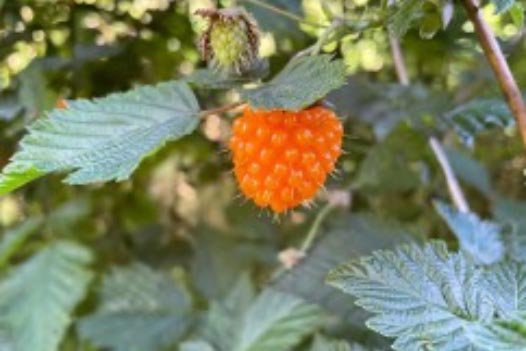Salmonberries, My Favorite Shrub
by Gary Ingram
Last night we had a small gathering at our farmstead and a young lady and I were the only ones feasting on the fat juicy salmonberries that grow in absolute abundance on our land. I told her it’s like eating small grape-fruits. Her response was a sly smile, sharing a secret that few of us know.
The salmonberry, Rubus spectabilis, is a native shrub of the Pacific Northwest that some love and many hate. I personally think it’s spectacular. People are surprised when I tell them that salmonberries are in the rose family, as they think of it as a poor man’s raspberry. The raspberry is also in the rose family.
Salmonberries ripen about the same time the salmon returns to our streams. Indigenous people of this area would spread these berries on cooked or smoked salmon.
It’s a deciduous shrub growing over 12 feet high. It loves wet soil and full sun but will grow just about anywhere on our place, even in the thick alder forest. Most of the berries are orange, like the salmon, but some are a deep and beautiful red. The taste is a combination of sweet, sour and bitter. We do some vigorous hikes around our place and, for me, there is nothing more satisfying than a ripe salmonberry when I’m thirsty.
The salmonberry is the first flowering native plant, blooming out in early spring; its pink flowers feed our native bumblebees and hummingbirds. Bees are invaluable and the bumblebee emerges in early spring just as these flowers open. Bumblebees are annual bees and only the newly fall-bred queen overwinters, coming out in the spring to feast on the nectar of the salmonberry be fore laying her eggs. Scientists are now telling us the bumblebee is in danger, as it has been losing much of its natural habitat. Enter the salmonberry, a thorny bramble that people hate but is critical to our native creatures.
I’ve been trying to raise honeybees for over 10 years with mixed success, while the bumblebee has flourished here on our farm.
The health benefits of the salmon-berry for humans are off-the-chart good. Like its cousin the raspberry, you name it, and it has it.
We see much of our land as a type of bird sanctuary and our 10,000 or so salmonberry plants feed many of them. Sitting on our deck and watching the western tanager, with its striking colors, feasting on these berries is one of my favorite things to do.
We were walking our road the other evening and two of our neighbors were standing in awe while looking at a mature salmonberry shrub full of ripe berries. They had removed most of the native plants from their 10 acres and planted grass and bamboo. They told us they have a different forest management plan than we do. Ours is simple and takes little energy from us, as we let nature do whatever it wants.

